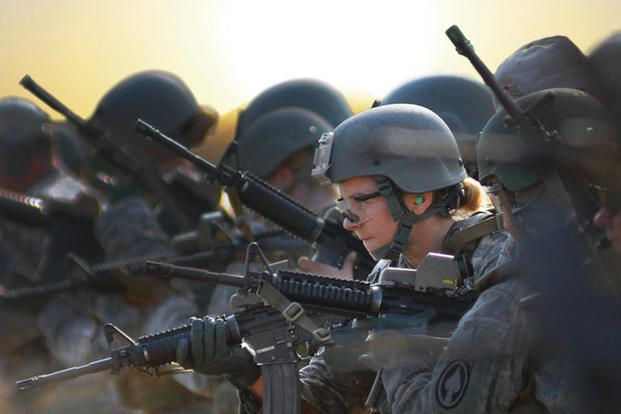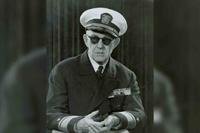People who like compelling, well-crafted tales of America’s soldiers in action will like Ashley's War: The Untold Story of a Team of Women Soldiers on the Special Ops Battlefield. Gayle Tzemach Lemmon’s recently released book tells the story behind the first team of female soldiers to join American special operators on the battlefield. The key to this book, however, is not simply that they are strong females, but that they are strong soldiers.
That message appears in the very first pages of the book, where she follows two soldiers on their first mission. The “newbies,” as she calls them, are preparing to go on a dangerous operation with an aggressive, seasoned Ranger team to capture an insurgent leader deep in Afghanistan. Lemmon identifies the newbies as “Second Lieutenant White” and “Staff Sergeant Mason,” sharing only at the very end of the introduction that White and Mason are women.
The book then flashes back to the story behind the creation of this unique unit, called Cultural Support Teams or CSTs. In 2010, the military’s Special Operations Command faced a problem – due to cultural mores that at best frowned on male-female interaction, American combat troops were effectively prohibited from communicating with Afghan women. That left half of Afghanistan’s population – potential sources of intelligence and partners to build lasting relationships – out of reach to American troops. So senior special operations commanders developed the CSTs to place female soldiers with American special operators in combat situations and engage with Afghan women on sensitive missions.
In describing the genesis of the CSTs as a unit, Lemmon also presents several of the individuals who volunteered for the pilot program. They are a cast of real characters, but make no mistake – these are smart alpha-women who are as fit and committed to success as any elite athlete. Readers learn about Anne Jeremy, the “serious, no-nonsense” officer who proved herself in combat by leading her convoy through a Taliban ambush of heavy arms fire that endured intermittently for 24 hours; Lane Mason, the 23-year-old Iraq War veteran who was a high-school track star in Nevada and volunteered for the CSTs to face down some demons in her past; Amber Treadmont, the intelligence officer from rural Pennsylvania who printed out the CST application within one minute of learning about the program; and Kate Raimann, the West Point grad and military police officer who played on her high school’s football team for all four years even though she hated football, just to prove that she could do it.
Lemmon’s depictions of these women are vivid, giving readers a textured understanding of who they are and what drove them to volunteer for an unprecedented program that would place them in incredibly dangerous situations. In fact, these nuanced profiles raise my sole problem with the book – namely, that there were so many interesting personalities that I couldn’t keep track of them all. Lemmon used a few Homeric epithets, like reminding readers late in the book that Lane was “the Guard soldier and track star from Nevada,” but a few more mental cues might have helped keep everyone straight.
But those are small drops of concern amidst an ocean of good writing and compelling moments. Lemmon deftly draws readers through the brutal candidate assessment (“100 hours of hell”), the women’s anxiety about whether they would be selected, their post-selection training at Fort Benning, and their subsequent deployments to Afghanistan.
One scene in particular encapsulates the challenging nature of the CSTs’ role. Kate, the football-hating football player, was on a raid of a compound to capture a key Taliban fighter. Her job, like all of the CSTs, was to assemble the compound’s women and children, gather as much information from them as possible, and protect them if necessary. Soon after the Afghan and American forces entered the compound, heavy contact erupted, and Kate began shepherding the group of women and children to a building nearby.
As she directed [the interpreter], Kate scooped up a small baby, barefoot and crying. She threw the little guy over her left shoulder and took off running as the sound of gunfire grew louder behind her. Using her right arm she grabbed the hand of a small girl and drew her close to her body.
“Stay with me, stay with me!” Kate urged, hoping the child would trust and understand her movements even if she didn’t understand her words.
Suddenly Kate felt the jagged terrain take hold of her left foot. She began tumbling forward as one of her boots got trapped in a deep hole she hadn’t detected through the green film of her night-vision goggles.
The baby, Kate thought. Instinctively she held him tight against her chest as the momentum of her fall sent her spinning into a diving, forward roll. She released the little girl’s hand just in time to keep her from falling, too.
A second later Kate lay on her back with the baby tucked up against her body armor. He hadn’t moved despite the somersault and was now just looking at her wide-eyed and silent.
Kate felt the baby’s warm breath on her neck, looked up at the twinkling stars above, and heard the rat-a-tat-tat of gunfire around her, maybe three dozen feet away.
What the fuck is my job right now? she asked herself as she hugged the baby tight and again took the hand of the little girl who was standing nearby. This is crazy.
The book juxtaposes “crazy” moments like that with poignant moments that further illustrate the CSTs’ unique position as women in combat environments. In one anecdote, a female civilian interpreter from California named Nadia meets three new CSTs, and they bond over perhaps the most non-military item of all: mascara.
The four women – Ashley, Anne, Lane, and Nadia – were in the washroom getting ready for the first meeting of the day when Anne and Lane broke out their traveling cosmetic kits. It was a small gesture, but for Nadia, it spoke volumes.
During her years overseas she had been around a lot of military women who frankly frightened her. They conveyed the impression that any sign of femininity would be perceived as weakness. But here, in this tiny bathroom, were three incredibly fit, Army-uniformed, down-to-earth gals who could embrace being female and being a soldier in a war zone. She found it refreshing – and inspiring.
“Oh my God, you wear makeup!” she burst out.
Anne laughed as she put the final touches on an abbreviated makeup regimen.
“Oh, yes, always have to have mascara on,” she replied. “I am blond and look like I have no eyelashes. I don’t want to scare people!”
Lemmon also peppers the book with several sidebars that add interesting and important context, like the value of interpreters and the history of military dogs. While a discussion about the evolution of female soldiers’ uniforms may not seem terribly interesting on its face, she deftly weaves it into the story because it mattered to the CSTs – the ill-fitting gear was obviously designed for men and therefore had bulges in places where the women didn’t need them and lacked material where they did. That seemingly whimsical anecdote illustrates just how unprecedented their mission was.
The book builds to an emotional climax with – spoiler alert – the first death of a CST soldier. It’s an undeniably tough moment, and Lemmon treats the subject – the agonized reaction of the soldier’s family and her sister CSTs – with appropriate respect. The Rangers serving with the deceased soldier sent the family a condolence card, with an important quote:
“Having a woman come out with us was a new thing for all of us,” wrote her weapons squad leader. “Being one of the first groups of CST, she really set a good impression not only on us, but also the higher leadership. I am sorry for your loss, but I want you to know that she was good at her job and a valuable member of this platoon.”
That statement, to me, seemed to summarize the whole point of the book: these women are not just strong females – they are strong soldiers.
* * *
Mark Lee Greenblatt is the author of Valor: Unsung Heroes from Iraq, Afghanistan, and the Home Front, (Taylor Trade, 2014), which is available on Amazon and at Barnes & Noble and independent bookstores across the country. Mark has been appeared on NBC, CBS, MSNBC, Fox News Radio, CSPAN-Book TV, Wall Street Journal TV, Forbes.com, and dozens of other media outlets. Visit Mark's website to learn more about the heroes in Valor or to send an email to the heroes.




